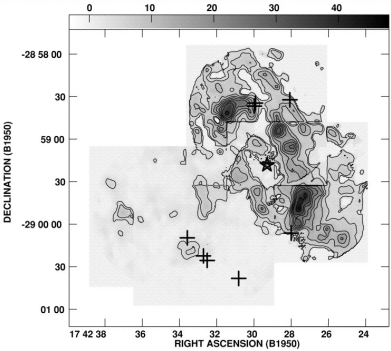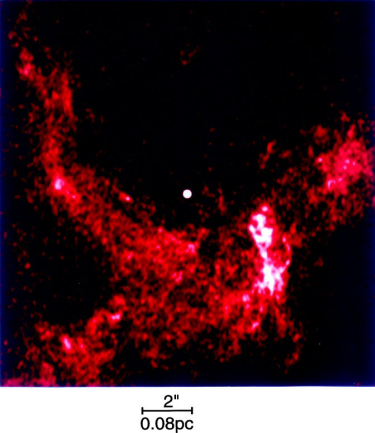
The circumnuclear disk and Sagittarius A West
 المؤلف:
Heino Falcke and Friedrich W Hehl
المؤلف:
Heino Falcke and Friedrich W Hehl
 المصدر:
THE GALACTIC BLACK HOLE Lectures on General Relativity and Astrophysics
المصدر:
THE GALACTIC BLACK HOLE Lectures on General Relativity and Astrophysics
 الجزء والصفحة:
p 107
الجزء والصفحة:
p 107
 26-1-2017
26-1-2017
 2350
2350
The circumnuclear disk and Sagittarius A West
Well within the central molecular zone lies a disk of molecular gas which surrounds and orbits the central black hole. This distinctive structure is important because of its potential for providing matter to the black hole. At present, this circumnuclear disk (CND) has an inner cavity with a radius of about 1 pc, and the disk can be followed out to as much as 7 pc in some directions with molecular line observations (Morris and Serabyn 1996). The CND is inclined by about 60o to the line of sight (see figure 4.9), so it is in fact tilted with respect to the Galactic plane (Gusten et al 1987; Marshall et al 1995). This is a very fortunate circumstance, because, if the CND were aligned with the Galactic plane, or if it were edge-on to our line of sight in some other plane, then the extinction through this disk would have made the study of stars and gas in the central parsec extremely difficult.
The CND was discovered in the far-infrared, at a wavelength of 100 μm (Becklin et al 1982), where, because of limb-brightening, it appears as two lobes of emission straddling Sgr A* the compact radio core. The prominent far-infrared emission from the CND emanates from the warm dust heated by the extremely luminous, hot stars in the central stellar cluster (Davidson et al 1992; Dent et al 1993; Telesco et al 1996). A layer of gas at the abrupt inner edge of the disk is ionized (at least where the UV starlight is able to reach that inner edge; the gaseous features comprising the H II region Sgr A West, described later, apparently block some of the ionizing radiation from reaching the CND). Immediately exterior to the ionized ring is a ring of shocked molecular hydrogen, as is shown in figure 1.1 (Yusef-Zadeh et al 2001). The CND is a clumpy structure on all scales which have been used to observe it. This implies, in principle, that UV radiation from the enclosed stars can penetrate much further into the disk than would be possible if the medium were uniform. The penetration of UV radiation also leads to a thick photodissociation region in the interior portions of the CND, where atomic and molecular gas coexist (C II, Lugten et al 1986; H2, Gatley et al 1986, Yusef-Zadeh et al 2001; O I, Jackson et al 1993; C I, Serabyn et al 1994; HCN, Marshall et al 1995; other molecules, White 1996 and Wright et al 2001). The detailed microstructure of the CND has been modeled by Vollmer and Duschl (2000, 2001a, b).

Figure 1.1. The circumnuclear disk, as seen in NIR emission from shocked molecular hydrogen by the NICMOS camera on the Hubble Space Telescope (from Yusef-Zadeh et al 2001). This mosaiced image shows the gray scale and contours of velocity-integrated H2 S(1) 1–0 line emission. The star at the center of the configuration shows the location of the radio counterpart to the Galactic black hole, Sgr A*. The square in the ring is due to artifacts of mosaicing. The plus signs mark the positions of 1720 MHz OH masers, which Yusef-Zadeh et al (1996) argue are due to shocked molecular gas. The shocked molecular hydrogen arises primarily near the inside edge of the circumnuclear disk, where it is presumably shocked by the impact of the high-velocity winds from the hot stars residing in the central parsec.
The CND has a relatively flat rotation curve, starting at about 110 km s-1 at its inner edge (Roberts and Goss 1993). The determination of the rotation curve requires knowledge of the possibly radius-dependent orientation of the disk plane (Marshall et al 1995), and this is not yet well determined. This orientation depends in detail on the recent history of the CND, for example, whether it is a result of slow accretion of material migrating inwards from the CMZ or whether it is a dispersion ring resulting from the tidal alteration of a dense cloud which recently passed within a few parsecs of the central black hole and got sheared into a self-intersecting orbit (Sanders 1998). The CND is apparently approximately circular at its inner edge, but its outer contours deviate strongly from axisymmetry (e.g. Morris and Serabyn 1996). This can be accounted for by Sanders’ model, but an alternative effect that merits consideration is that the blast wave of the supernova remnant Sgr A East (see later) has recently passed by the CND, and has deformed its originally more symmetric geometry (Maeda et al 2002).
CNDs are common to a large fraction of gas-rich spiral galaxies, notably many with active galactic nuclei. The Hubble Space Telescope (HST) has imaged many of them, and their physical scales tend to be larger (∼100 pc) than that of our Galaxy's CND, but that is likely to be a selection effect because that is the scale corresponding to the resolving power of the HST. The importance of all these disks is that they are likely to serve as reservoirs for fuel for the central black holes of these galaxies. These disks are also likely to be rich in star formation, and may be especially important in starburst galaxies. Our Galaxy's CND is currently the only gaseous structure which might conceivably fuel star formation in the central parsec, although there is no evidence that the CND is forming stars at the present time.
Sagittarius A West consists of all the ionized gas at the inner edge of the CND and the plasma structures within the central cavity of the CND. In radio continuum images (figure 1.2) and images made from infrared lines characteristic of H II regions (including radio recombination lines, Brackett-γ , and [Ne II] 12.7 μm), Sgr A West assumes the form of a three-armed, triskelian, pattern, probably as the result of the superposition of several more-or-less independent structures projected along our line of sight, rather than because there is a real three-armed structure in this direction.
At least two of the features in Sgr A West the Northern and Eastern1 Arms appear to be infalling streams of gas. Their kinematics have been modeled in terms of gas accelerating inwards toward the black hole on highly eccentric orbits (Serabyn et al 1988; Herbst et al 1993; Roberts et al 1996; Morris and Maillard 2000; Vollmer and Duschl 2000). The leading apex of these streams is well defined and indicates that, while close to the central black hole, the orbital motion has not yet carried the apex past periapse. One might anticipate that, on a timescale as short as 104 years, at least one of these streams will self-intersect and create a dispersion ring well within the inner cavity of the CND. If the two streams collide, the dynamics will be more complex, and the angular momentum loss will lead to an even more compact disk around the black hole. In either case, the accretion rate onto the black hole is likely to be considerably enhanced over its present, relatively small rate. The origin of these streams is still unclear; possibilities include:

Figure 1.2. Radio continuum image of the central portion of Sgr A West, made at 1.3 cm wavelength with the VLA by Zhao and Goss (1998). The spatial resolution of this image is 0.1''. Sgr A* is the prominent point source at the center of the image, while the Northern Arm falls from the northeast (top left) around Sgr A* to the south, where it joins the ‘mini-cavity’, centered ∼3'' to the southwest of Sgr A*. The Eastern Arm comes in from the southeast, and the extended emission feature cutting through the mini-cavity from southeast to northwest is the ‘bar’.
(2) collision of a small cloud with the CND, leading to local angular momentum loss, with subsequent infall (Jackson et al 1993), and
(3) a low-angular-momentum gas cloud from well beyond the CND, now approaching its pericenter distance. The presence of presumably infalling molecular gas streams on somewhat larger scales (e.g. McGary et al 2001) would favor the last two possibilities.
 الاكثر قراءة في الثقوب السوداء
الاكثر قراءة في الثقوب السوداء
 اخر الاخبار
اخر الاخبار
اخبار العتبة العباسية المقدسة


